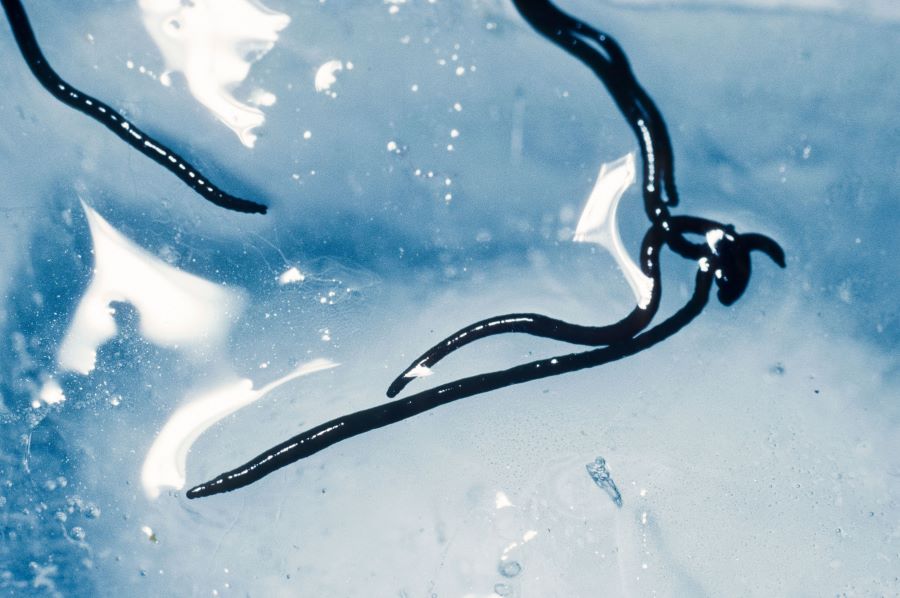How do ice worms survive in glaciers?
Mesenchytraeus solifugus is the name of a species of ice worms that thrive at temperatures below zero on Pacific Northwest glaciers, which are their natural habitat.
The ice or snow worms, to call them more conveniently, are 12 to 15 millimeters long and half a millimeter thin. They live mostly in the cold parts of North America such as Alaska, British Columbia, the state of Washington. No other ecosystems are known to host these creatures, and this makes them unique.
This species was first reported from Muir Glacier in Alaska. Italian entomologist Carlo Emery named it solifugus in 1898, meaning "fleeing from the sun." Phylogeny suggests that it evolved from an aquatic ancestor.

The Muir Glacier in 1941 and 2004. Credit: NASA
During the summer, they crawl up in the afternoons and evenings to feed on algae, microbes, bacteria, and other microorganisms on the surface, and at dawn they hide back into ice in order to avoid sunlight. In winter, they are believed to dive deep into ice, though scientists knew little until now what the ice worms actually do during this season.
The laws of biology dictate that the reactions within the body slow and energy consumption drops when temperatures decrease. In warm-blooded animals, energy is burned to keep a relatively constant temperature, while cold-blooded organisms become sluggish and even go dormant when it gets too cold. But not the ice worms.
More to read:
Scientists learned how parasitic worms highjack their hosts
So, what are the tricks behind the survival of ice worms at extreme temperatures, considering that it would be impossible for most creatures, especially cold-blooded ones without any insulation?
Learning more about how these animals tolerate extremes can help us understand the limits of life on Earth and beyond, Daniel Shain, a Rutgers University researcher who has studied these worms for 25 years told the National Geographic.
He observed a paradox with the Mesenchytraeus solifugus ice worms: as they get colder their energy levels go up.
Given that glaciers around the world have been melting for a while as a result of climate change, there’s a risk that the Mesenchytraeus solifugus species will vanish into history, he has led a number of studies (here, here, and here) in recent years to explain this paradox.

Doctor Daniel Shain of the Rutgers University has been studying the ice worms for 25 years. Credit: Rutgers University
Shain has discovered that the reason lies in a special molecule known as ATP, short for “adenosine triphosphate.” It functions as the primary energy currency within cells and fuels the majority of bodily reactions. Then the intricate process of ATP synthesis relies on a complex enzyme called ATP synthase, a structure remarkably consistent across all known organisms. Remarkably, this molecule operates with close to 100% efficiency, an unprecedented feat in the realm of non-biological world.
However, ice worms introduce a unique modification to this machinery through an additional segment in their DNA responsible for ATP synthase production. This genetic alteration seems to enhance the speed of ATP generation, likened to the effect of a turbocharger, according to the researcher.
More to read:
Learning from termites: Building better, energy-saving homes
Shain and his colleagues believe that the worms had acquired this genetic addition through a process resembling gene theft, potentially assimilating genetic material observed in high-altitude fungi. This hypothesis is quite intriguing, because stolen DNA does not typically integrate into the mitochondria, the cellular organelles where ATP is synthesized.
That’s not all.
In addition to the genetic modification, the ice worms possess a modified cellular "thermostat" that allows for the continued production of ATP even in cold temperatures.
The combination of these two alterations results in significantly higher cellular concentrations of ATP compared to most other creatures. This phenomenon provides insight into how ice worms manage to sustain their energy levels in freezing conditions.

Ice worms seen through a microscope. Credit: HakaiMagazin
Mesenchytraeus solifugus worms live their entire lives in snow or ice, at temperatures around 0 degrees Celsius. Their dark pigmentation helps protect it from solar ultraviolet radiation. Their fluid and flexible bodies are able to squeeze through air holes and tiny crevasses in ice. The lifespan of an ice worm is believed to be five to ten years.
They freeze at around −6.8 °C and their bodies decompose after continuous exposure to temperatures above 5 °C. This decomposition process occurs when the cells produce digestive enzymes and self-destruct. The body, figuratively speaking, melts.
A similar species of ice worms live in Tibet, under pretty similar conditions. Just like their American cousins, they are threatened by extinction due to global warming.
***
NewsCafe is a small, independent outlet that cares about big issues. Our sources of income amount to ads and donations from readers. You can buy us a coffee via PayPal: office[at]rudeana.com.







